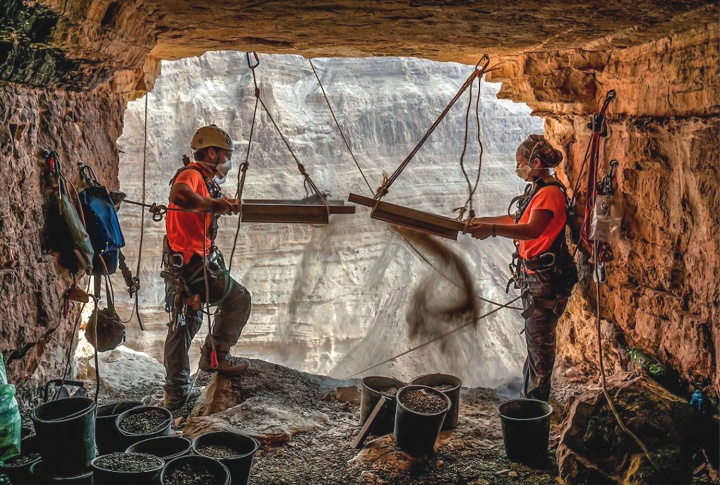Recent Holy Land Finds Support the Biblical Record
Downloads
Recent Holy Land Finds Support the Biblical Record

Thick wall at Lachish dated to King Rehoboam (April 23, 2019). Olive pits in the foundation of a thick wall at Tel Lachish, southwest of Jerusalem, were carbon dated to about 920 B.C., aligning with the time of Solomon’s son Rehoboam. Scripture says that Lachish was one of the cities of Judah fortified by Rehoboam (2 Chronicles 11:9).
Copper mining deposits evidence of Edomite kingdom (Sept. 18, 2019). Chemical and microscopic analysis from copper slag deposits in the Aravah Valley, where the biblical kingdom of Edom sat, showed the same standardized advanced refining techniques being used over widely scattered locations, evidence of a strong, central government before the mid-11th century B.C., 300 years earlier than scholars had thought. Scripture already attested there were kings reigning over Edom before any kings of Israel (Genesis 36:31).
Hebrew Yahwistic name at Abel Beth Maacah (Jan. 16, 2020). Disbelieving the biblical picture of the powerful Israelite state under King David, many have thought Abel Beth Maacah, on the northern border of Israel, was outside Hebrew domain from the 900s to 800s B.C. But a wine jar from this period was found here with the inscription “of Benayo,” a Hebrew name ending in a form of Israel’s God Yahweh. This town provided refuge to the rebel Sheba before delivering him up to David’s besieging forces (2 Samuel 20:14-22).
Massive administrative center from the late Kingdom of Judah (July 22, 2020). One of the largest collections of Kingdom of Judah seal impressions has been found at a huge public tax collection and storage complex from the late 8th to mid-7th centuries B.C., the time of King Hezekiah and his son King Manasseh, near the new U.S.
embassy in Jerusalem. More than 120 jar handles are stamped with lmlk, meaning “of the king.” Excavation has revealed the site continued in operation after the Assyrian King Sennacherib came against Judah in 701 B.C., consistent with the Bible’s description of Hezekiah’s reign.
Proto-Aeolian column capitals outside Jerusalem’s walls in Hezekiah’s time (Sept. 3, 2020). Three scaled-down versions of earlier Phoenician-style volute column heads, such as adorned David’s palace, were apparently part of a lavish mansion outside Jerusalem’s defensive walls as part of the city’s continuing expansion under Hezekiah after Sennacherib’s forces left, again consistent with the biblical picture of the city’s survival and wealth beyond the siege.
Royal purple dye on fabrics from David and Solomon’s time (Jan. 28, 2021). Three pieces of wool clothing, out of more than a hundred discovered at the ancient copper mines of Timna in southern Israel, were found dyed with royal purple. These were carbon dated to around 1000 B.C., the time of David and Solomon. This dye, produced in small quantity from a particular species of Mediterranean sea snails, required long and laborious extraction and processing.
Purple fabric was thus very expensive, sometimes more than gold, and worn only by royalty, high officials and others of great wealth (compare Song of Solomon 3:9-10). The discovery of purple cloth at Timna along with bones of fishes imported from Egypt argues for a significant trading network and a strong central government overseeing it—fitting with that of David and Solomon.
New Dead Sea Scrolls fragments first Bible texts found in 60 years (March 16, 2021). A four-year operation by the Israel Antiquities Authority, including scouring remote caves, has turned up 80 new scroll fragments bearing lines of Greek text from Zechariah and Nahum. These are believed to have been part of a set of fragments of the Twelve Minor Prophets from the “Cave of Horrors,” named for 40 human skeletons found there in excavations in the 1960s.
The scroll is thought to have been stashed during the Jewish Bar Kokhba Revolt against Rome (A.D. 132-136). Some have noted minor textual variants, but such scrolls have shown very little difference from our Bibles today, as is also the case with the new fragments. And note again that this was a Greek translation rather than a Hebrew version following a stricter scribal tradition.
Earliest alphabetic writing in the Holy Land found at Lachish (April 20, 2021). A small potsherd found at Tel Lachish in southern Israel contains the earliest alphabetic writing found in the southern Levant, carbon dated to the 15th century B.C. Two short lines of Semitic text read ‘abd, meaning “servant” (perhaps as part of a name) and npt, possibly meaning honey (Hebrew nophet). Some are calling it a “missing link” between earlier Egyptian alphabetic writing and later writing in the Levant. This is yet another blow to those who say Moses could not have written the Torah in Hebrew, given that he supposedly lived well before such alphabetic writing. This inscription is dated to right around the time of Moses.
Inscription possibly reading Jerubbaal, another name for Gideon (July 13, 2021). Excavations at Khirbet al-Ra‘i, near Lachish, have revealed a name written across three pottery fragments. Four letters are clear, rb’l, reading rubbaal. The preceding first letter is not fully preserved but may be a yod, yielding the name Yrb’l (Jerubaal). This was another name for the biblical judge Gideon after he tore down Baal’s altar (Judges 6:32; 7:1), and the inscription dates to about 1100 B.C., around the time Gideon died.
However, Scripture makes no mention of Gideon’s influence in Judah, noting only his activity in the north of Israel and the east. Some propose the inscription could read Azrubaal, Zecharbaal or Meribbaal. Yet Gideon did have a long judgeship with a succession controversy among his sons afterward, so his name could have been significant as far as Judah—and someone there could have been named after him.
East section of Jerusalem city wall from the time of Hezekiah and Josiah (July 14, 2021). Finding a lengthy section of city wall on the steep east side of the City of David, heretofore missing in tracing the eastern fortification of the city in the 8th-7th centuries B.C., allows archaeologists to see the full run of the wall that encircled Jerusalem prior to its Babylonian destruction.
The wall section was previously not considered fortification due to belief that the Babylonians had left no such structure standing, based on 2 Kings 25:10 stating they “broke down the
walls of Jerusalem all around.” Some are now claiming the new finding contradicts that verse. But the verse does not say there were no parts of the wall left standing. The wall was reduced here, with some hard-to-reach stretches left standing, and Nehemiah later had to do a lot of restoration work. So the walls were indeed broken down all around, as the Bible says.
Jerusalem excavation uncovers evidence of earthquake in Amos and Zechariah (Aug. 4, 2021). The biblical book of Amos was written in the 8th century B.C. during the period of Judah’s king Uzziah and Israel’s king Jeroboam II and gives the benchmark “two years before the earthquake” (Amos 1:1). This was evidently a memorable massive earthquake in which people fled from Jerusalem, recalled around 250 years later in Zechariah 14:5 even after national captivity and restoration.
Now archaeologists have found a destruction layer in Jerusalem’s City of David that fits with this time frame. The absence of fire damage from invasion solidifies the earthquake connection. Evidence of similar destruction has been found at other sites in the region, such as Hazor, Lachish, Gezer and Megiddo, but this is the first time it’s been found in Jerusalem. It can serve as a new dating anchor for archaeologists digging here.
UCSD archaeology professor Thomas Levy told Live Science, “When the biblical data is coupled with the archaeological and paleo-seismic data from the southern Levant, a strong correlation is clearly seen between the Book of Amos, a prophet in the Hebrew Bible, and the archaeological record.”
Missing wall section at Gath shows where Aramaean forces invaded (Aug. 8, 2021). The Bible states that the Aramaean or Syrian king Hazael fought against the Philistine city of Gath and took it (2 Kings 12:17). There has been plenty of archaeological evidence of this siege and destruction in the 9th century B.C. both inside and outside the city, earlier hometown of Goliath and now known as Tell es-Safi, but researchers couldn’t find where the city’s fortification wall had been breached.
Now a 30-foot gap in the wall has been found at the lowest part of the city, right next to a heavily fortified gate to reach the city’s water supply. Archaeologist Aren Maeir believes this may be “the earliest known, on-the-ground evidence of a siege from the entire world.”
Again and again, the Bible is vindicated in its recording of not myth, but actual history!
